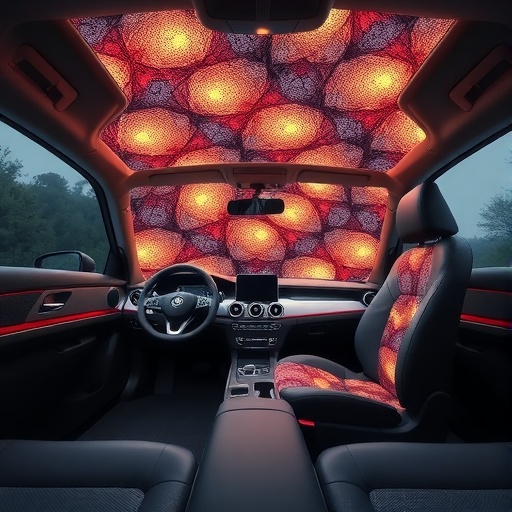In an astonishing breakthrough in automotive acoustics, researchers have developed a novel approach to improving sound quality within car cabins using cleverly designed metamaterials based on the concept of fractals. Car owners often invest considerable sums into high-quality audio systems, yet many still experience uneven sound distribution due to the peculiar acoustics of vehicle interiors. Recognizing this prevalent challenge, a team from various Chinese institutions sought to leverage the unique properties of fractals to create a more harmonious auditory experience for all passengers.
Fractals are geometric shapes that exhibit self-similarity, meaning that their structure remains consistent at different scales. A well-known example is the Koch snowflake, which can be constructed by recursively adding smaller triangles to each side of an equilateral triangle. By incorporating the principles of fractal geometry, the researchers set out to produce a metamaterial that could manipulate sound waves effectively while remaining compact enough to integrate seamlessly into car audio systems.
The study detailed in the Journal of Applied Physics reveals how the created metamaterial employs wave-bending characteristics to enhance sound diffusion within automotive environments. Traditional loudspeakers often struggle to provide a balanced sound experience, commonly leaving passengers with a less than optimal auditory experience. The innovative metamaterial, designed specifically to manage sound wave diffraction, allows for improved distribution of acoustic energy throughout the vehicle.
Ming-Hui Lu, one of the principal investigators, explains the mechanics behind the fractals utilized in this research. He indicates that as sound waves interact with obstacles that are similar in size to their wavelengths, diffraction becomes a significant factor affecting sound quality. The researchers’ approach harnessed the scalability of fractals, allowing them to increase the edge surface area without expanding the size of the metamaterial dramatically, thus maintaining its apposite use in tight automotive spaces.
Through their meticulous studies, the researchers observed that increasing the Koch fractal dimension contributed to enhanced edge diffraction. This phenomenon results in a more uniform spread of sound waves, creating a more comfortable auditory environment for all occupants of the vehicle, whether they are seated in the front or rear.
To validate their findings, the team molded the fractal designs into a material that could be placed over existing loudspeakers. They conducted a series of controlled sound pressure level tests in vehicles, measuring the sound distribution across various seating positions. The results were impressive: the metamaterial led to a substantial reduction in sound quality disparities, even in challenging high-frequency ranges often associated with distortion in conventional speaker systems.
Lu expressed excitement over the laboratory and in-vehicle tests, describing how they consistently reflected one another. This correlation not only underscores the reliability of the findings but also provides a strong foundation for future automotive applications. The consistent performance of the fractal metasurface showcases its effectiveness in real-world environments, which is a significant advancement over purely theoretical experiments.
The potential commercial impact of this research is substantial; the team is actively collaborating with Chery Automobile Co., exploring opportunities to bring their innovative sound diffusion solution to market. Their goal is to incorporate the fractal metamaterials into new car models, bringing high-quality audio experiences to a broader audience.
The study offers a fascinating glimpse into the future of automotive design, where cutting-edge physics can transform mundane experiences into extraordinary ones. As car audio systems become more sophisticated, the integration of such advanced materials may soon become standard, enhancing entertainment while driving and promoting overall passenger comfort.
Furthermore, the researchers plan to investigate avenues for expanding the operational bandwidth of the metamaterials, which could further refine sound dispersion and elevate passenger experiences in cars across different genres and price ranges. The quest for improving acoustic systems is ever-evolving, and this research marks a significant milestone in the journey.
In summary, the developments stemming from fractal research signal an exciting era for automotive engineering that merges design, physics, and consumer experiences. As society leans further into embracing technology in everyday life, innovations such as this could redefine what listeners expect from their car audio environments.
As the researchers continue their pioneering work, the horizons of sound manipulation in automotive contexts expand, promising richer sound fields that satisfy even the most discerning audio aficionados. It is an intersection of science and practicality that propels not just the automotive industry but also innovations in how we experience sound in enclosed environments.
In conclusion, the collaboration of scientific principles and applied engineering paves the way for a new generation of car audio solutions that are as captivating as they are revolutionary. With ongoing refinements and potential commercial applications on the horizon, the future of sound in vehicles looks exceptionally promising.
Subject of Research: Fractal acoustic metamaterials for sound diffusion in automotive systems
Article Title: Koch snowflake-inspired acoustic metasurface for broadband sound diffusion in automotive loudspeaker systems
News Publication Date: 11-Nov-2025
Web References: Journal of Applied Physics, DOI: 10.1063/5.0277003
References: N/A
Image Credits: Li et al.
Keywords
Fractals, Sound Manipulation, Acoustic Metamaterials, Automotive Sound Systems, Loudspeaker Technology, Sound Diffusion, Koch Snowflake




